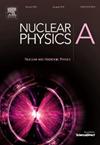The 7Be(d, α)5Li(p α) and 7Be(d, p)8Be*(p 7Li) reactions at 5 MeV/u
IF 2.5
4区 物理与天体物理
Q2 PHYSICS, NUCLEAR
引用次数: 0
Abstract
The Be(d, Li and Be(d, p)Be(p Li) reactions are studied at 5 MeV/u in the context of the cosmological lithium problem. This work aims to probe the contribution of Be destruction mechanisms, particularly through channels that populate intermediate unbound states of Li and Be. The contribution of Be(d, )Li(p ) reaction is separated from the Be(d, p)Be reaction. The Be(d, p)Be(p Li) channel is also identified and is useful for an indirect study of the Be(n, pLi reaction.
5mev /u下7Be(d, α)5Li(p α)和7Be(d, p)8Be*(p 7Li)反应
在宇宙锂问题的背景下,研究了7Be(d, α)5Li和7Be(d, p)8Be*(p 7Li)在5 MeV/u下的反应。这项工作旨在探索7Be破坏机制的贡献,特别是通过填充5Li和8Be的中间非束缚态的通道。7Be(d, α)5Li(p α)反应的贡献从7Be(d, p)8Be*(2α)反应中分离出来。还鉴定了7Be(d, p)8Be*(p1 7Li*)通道,该通道可用于间接研究7Be(n, p1)7Li*反应。
本文章由计算机程序翻译,如有差异,请以英文原文为准。
求助全文
约1分钟内获得全文
求助全文
来源期刊

Nuclear Physics A
物理-物理:核物理
CiteScore
3.60
自引率
7.10%
发文量
113
审稿时长
61 days
期刊介绍:
Nuclear Physics A focuses on the domain of nuclear and hadronic physics and includes the following subsections: Nuclear Structure and Dynamics; Intermediate and High Energy Heavy Ion Physics; Hadronic Physics; Electromagnetic and Weak Interactions; Nuclear Astrophysics. The emphasis is on original research papers. A number of carefully selected and reviewed conference proceedings are published as an integral part of the journal.
 求助内容:
求助内容: 应助结果提醒方式:
应助结果提醒方式:


